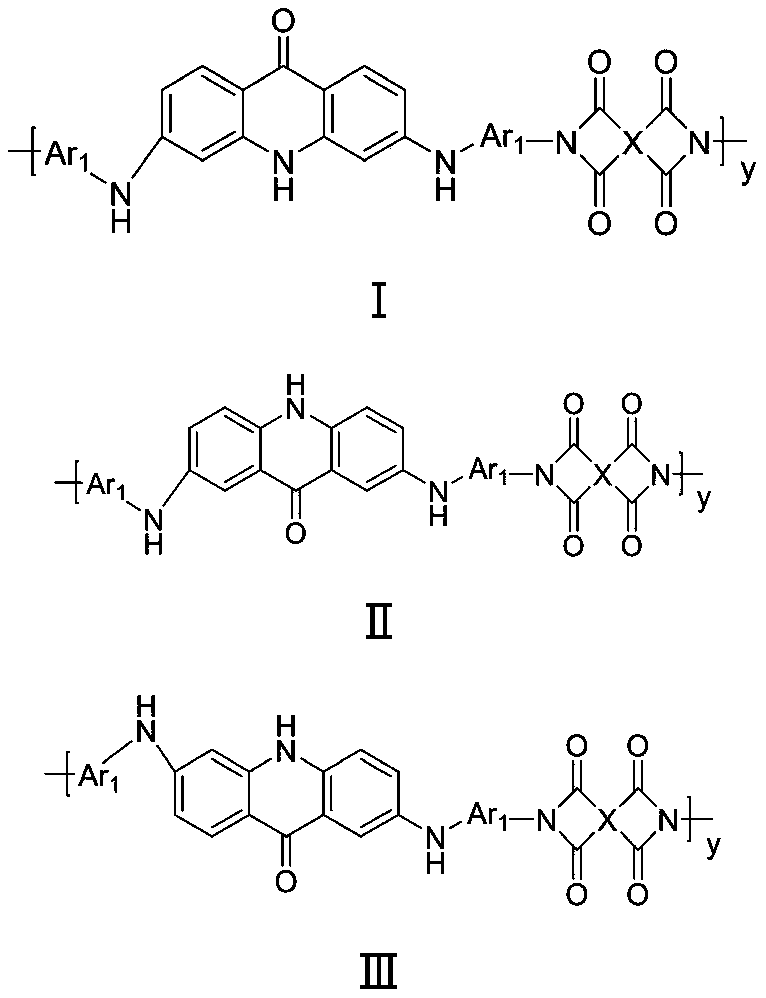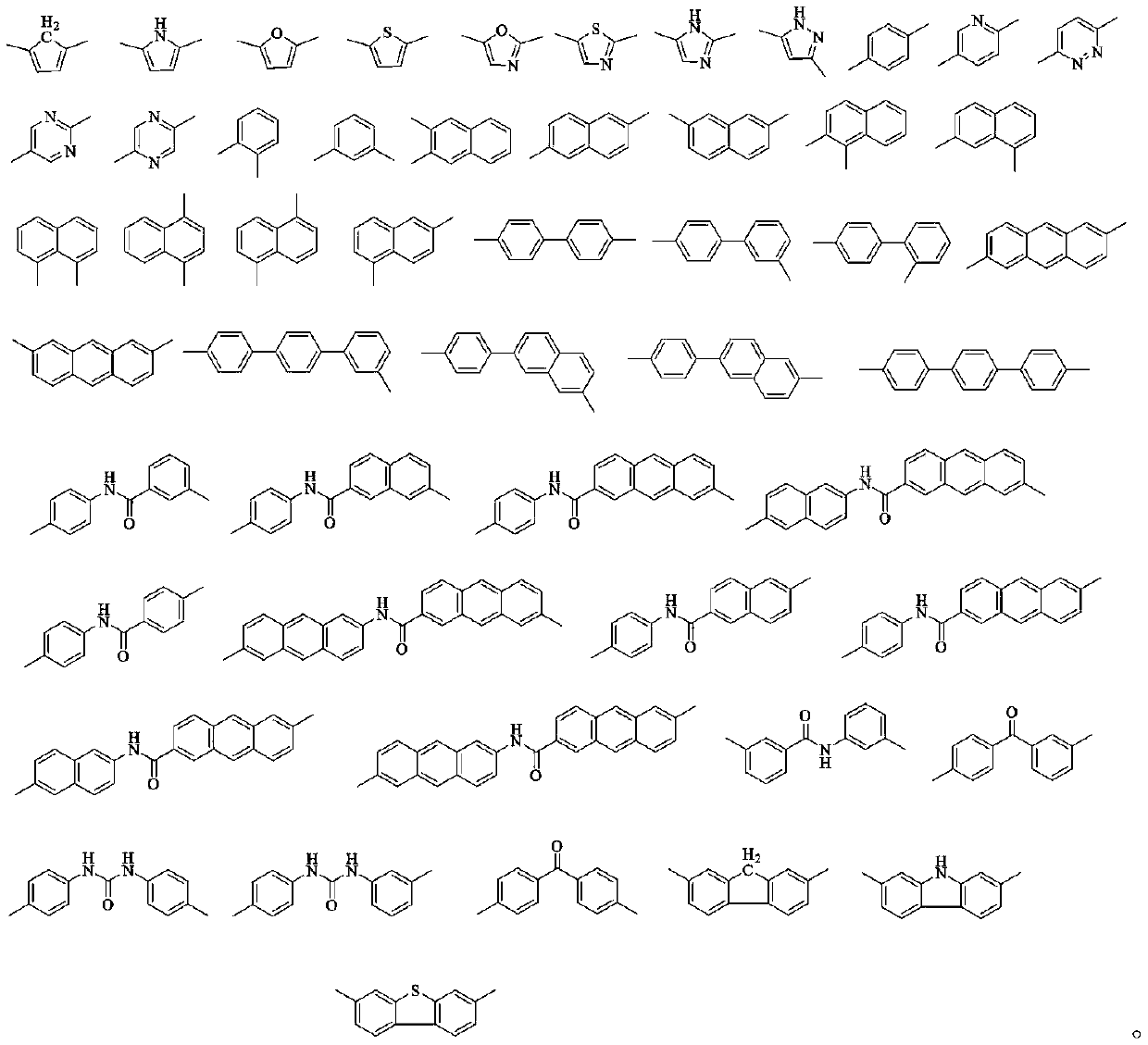Material with antibacterial performance, preparation method and application thereof
A performance and uniform technology, applied in the field of material science, can solve the problems of single thermal stability function and high water oxygen transmission rate of polyimide, so as to improve the glass transition temperature, improve the stability of heat resistance and oxidation resistance, Effect of improving barrier performance
- Summary
- Abstract
- Description
- Claims
- Application Information
AI Technical Summary
Problems solved by technology
Method used
Image
Examples
Embodiment 1
[0040] This example provides the synthesis of 2,7-bis((4-aminophenyl)amino)acridin-9(10H)-one:
[0041]
[0042] S1. Synthesis of intermediate 2,7-diaminoacridin-9(10H)-one:
[0043] Add 3.53g (0.01mol) of 2,7-dibromoacridin-9(10H)-one, an appropriate amount of cuprous oxide, 50ml of NMP, and 13ml of ammonia water (29%, 0.2mol) into a 200ml pressure-resistant bottle, protected by argon, at 100°C Reaction, after the reaction is completed, the reaction solution is poured into ice water, extracted with dichloromethane, the solvent is removed under reduced pressure, and the product is made of dichloromethane: n-hexane=2:1 (volume ratio) as the mobile phase silica gel as the stationary phase. After purification by column chromatography, the product was collected and spin-dried, and dried in vacuum at 80°C for 24 hours to obtain an intermediate. The intermediate structure is as follows:
[0044]
[0045] S2. Synthesis of intermediate 2,7-bis((4-nitrophenyl)amino)acridin-9(10...
Embodiment 2
[0051] This example provides
[0052] Synthesis of 2-((5-aminopyridin-2-yl)amino)-6-((6-aminopyridin-3-yl)amino)acridin-9(10H)-one:
[0053]
[0054] S1. Synthesis of intermediate 2,6-diaminoacridin-9(10H)-one:
[0055] Add 3.53g (0.01mol) of 2,6-dibromoacridin-9(10H)-one, an appropriate amount of cuprous oxide, 50ml of NMP, and 13ml of ammonia water (29%, 0.2mol) into a 200ml pressure bottle, under argon protection, at 100°C Reaction, after the reaction is completed, the reaction solution is poured into ice water, extracted with dichloromethane, the solvent is removed under reduced pressure, and the product is made of dichloromethane: n-hexane=2:1 (volume ratio) as the mobile phase silica gel as the stationary phase. After purification by column chromatography, the product was collected and spin-dried, and dried in vacuum at 80°C for 24 hours to obtain an intermediate. The intermediate structure is as follows:
[0056]
[0057] S2. Synthetic intermediates
[0058] 2...
Embodiment 3
[0065] This example provides the synthesis of 3,6-bis((3-aminophenyl)amino)acridin-9(10H)-one:
[0066]
[0067] S1. Synthesis of intermediate 2,6-diaminoacridin-9(10H)-one:
[0068] Add 3.53g (0.01mol) of 2,6-dibromoacridin-9(10H)-one, an appropriate amount of cuprous oxide, 50ml of NMP, and 13ml of ammonia water (29%, 0.2mol) into a 200ml pressure bottle, under argon protection, at 100°C Reaction, after the reaction is completed, the reaction solution is poured into ice water, extracted with dichloromethane, the solvent is removed under reduced pressure, and the product is made of dichloromethane: n-hexane=2:1 (volume ratio) as the mobile phase silica gel as the stationary phase. After purification by column chromatography, the product was collected and spin-dried, and dried in vacuum at 80°C for 24 hours to obtain an intermediate. The intermediate structure is as follows:
[0069]
[0070] S2. Synthesis of intermediate 3,6-bis((3-nitrophenyl)amino)acridin-9(10H)-one...
PUM
 Login to View More
Login to View More Abstract
Description
Claims
Application Information
 Login to View More
Login to View More - R&D
- Intellectual Property
- Life Sciences
- Materials
- Tech Scout
- Unparalleled Data Quality
- Higher Quality Content
- 60% Fewer Hallucinations
Browse by: Latest US Patents, China's latest patents, Technical Efficacy Thesaurus, Application Domain, Technology Topic, Popular Technical Reports.
© 2025 PatSnap. All rights reserved.Legal|Privacy policy|Modern Slavery Act Transparency Statement|Sitemap|About US| Contact US: help@patsnap.com



